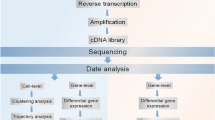Abstract
A major hurdle for the treatment of cancer is the incomplete understanding of its evolution through the course of its emergence, dispersal, and relapse. Genetic and epigenetic changes in combination with external cues and selective forces are the driving factors behind tumor heterogeneity. Understanding this variability within and across patients may partly explain the unpredictable outcomes of cancer treatments. Measuring the variation of gene expression levels within cells of the same tumor is a crucial part of this endeavor. Hence, the recently developed single-cell RNA-sequencing (scRNA-seq) technologies have become a valuable tool for cancer research. In practice, however, this is still challenging, especially for clinical samples. Here, we describe mcSCRB-seq (molecular crowding single-cell RNA barcoding and sequencing), a highly sensitive and powerful plate-based scRNA-seq method, which shows great capability to generate transcriptome data for cancer cells. mcSCRB-seq is not only characterized by high sensitivity due to molecular crowding and the use of unique molecular identifiers (UMIs) but also features an easy workflow and a low per-cell cost and does not require specialized equipment.
Access this chapter
Tax calculation will be finalised at checkout
Purchases are for personal use only
Similar content being viewed by others
References
Greaves M, Maley CC (2012) Clonal evolution in cancer. Nature 481:306–313
Maley CC, Aktipis A, Graham TA et al (2017) Classifying the evolutionary and ecological features of neoplasms. Nat Rev Cancer 17:605–619
Wu C-I, Wang H-Y, Ling S et al (2016) The ecology and evolution of cancer: the ultra-microevolutionary process. Annu Rev Genet 50:347–369
Podlaha O, Riester M, De S et al (2012) Evolution of the cancer genome. Trends Genet 28:155–163
Lipinski KA, Barber LJ, Davies MN et al (2016) Cancer evolution and the limits of predictability in precision cancer medicine. Trends Cancer Res 2:49–63
McGranahan N, Swanton C (2017) Clonal heterogeneity and tumor evolution: past, present, and the future. Cell 168:613–628
Turajlic S, Xu H, Litchfield K et al (2018) Deterministic evolutionary trajectories influence primary tumor growth: TRACERx renal. Cell 173:595–610.e11
Martincorena I, Raine KM, Gerstung M et al (2017) Universal patterns of selection in cancer and somatic tissues. Cell 171:1029–1041.e21
Tanay A, Regev A (2017) Scaling single-cell genomics from phenomenology to mechanism. Nature 541:331–338
Kolodziejczyk AA, Kim JK, Svensson V et al (2015) The technology and biology of single-cell RNA sequencing. Mol Cell 58:610–620
Ziegenhain C, Vieth B, Parekh S et al (2018) Quantitative single-cell transcriptomics. Brief Funct Genomics 17:220–232
Tirosh I, Izar B, Prakadan SM et al (2016) Dissecting the multicellular ecosystem of metastatic melanoma by single-cell RNA-seq. Science 352:189–196
Ebinger S, Özdemir EZ, Ziegenhain C et al (2016) Characterization of rare, dormant, and therapy-resistant cells in acute lymphoblastic leukemia. Cancer Cell 30:849–862
Picelli S (2017) Single-cell RNA-sequencing: the future of genome biology is now. RNA Biol 14:637–650
Darnell JE Jr (1968) Ribonucleic acids from animal cells. Bacteriol Rev 32:262–290
Ziegenhain C, Vieth B, Parekh S et al (2017) Comparative analysis of single-cell RNA sequencing methods. Mol Cell 65:631–643.e4
Parekh S, Ziegenhain C, Vieth B et al (2016) The impact of amplification on differential expression analyses by RNA-seq. Sci Rep 6:25533
Stegle O, Teichmann SA, Marioni JC (2015) Computational and analytical challenges in single-cell transcriptomics. Nat Rev Genet 16:133–145
Vallejos CA, Risso D, Scialdone A et al (2017) Normalizing single-cell RNA sequencing data: challenges and opportunities. Nat Methods 14:565–571
Bagnoli JW, Ziegenhain C, Janjic A, et al (2018) Sensitive and powerful single-cell RNA sequencing using mcSCRB-seq. Nat Commun 9:2937
Macosko EZ, Basu A, Satija R et al (2015) Highly parallel genome-wide expression profiling of individual cells using nanoliter droplets. Cell 161:1202–1214
Zheng GXY, Terry JM, Belgrader P et al (2017) Massively parallel digital transcriptional profiling of single cells. Nat Commun 8:14049
Parekh S, Ziegenhain C, Vieth B et al (2018) zUMIs – A fast and flexible pipeline to process RNA sequencing data with UMIs. Gigascience 7
R Development Core Team (2008) R: a language and environment for statistical computing. http://www.R-project.org
RStudio Team (2015) RStudio: integrated development environment for R. http://www.rstudio.com/
Lun ATL, McCarthy DJ, Marioni JC (2016) A step-by-step workflow for low-level analysis of single-cell RNA-seq data with bioconductor. F1000Res 5:2122
Bacher R, Chu L-F, Leng N et al (2017) SCnorm: robust normalization of single-cell RNA-seq data. Nat Methods 14:584–586
Thomas MP, Lieberman J (2013) Live or let die: posttranscriptional gene regulation in cell stress and cell death. Immunol Rev 253:237–252
DeAngelis MM, Wang DG, Hawkins TL (1995) Solid-phase reversible immobilization for the isolation of PCR products. Nucleic Acids Res 23:4742–4743
Author information
Authors and Affiliations
Corresponding author
Editor information
Editors and Affiliations
Rights and permissions
Copyright information
© 2019 Springer Science+Business Media, LLC, part of Springer Nature
About this protocol
Cite this protocol
Bagnoli, J.W., Wange, L.E., Janjic, A., Enard, W. (2019). Studying Cancer Heterogeneity by Single-Cell RNA Sequencing. In: Küppers, R. (eds) Lymphoma. Methods in Molecular Biology, vol 1956. Humana Press, New York, NY. https://doi.org/10.1007/978-1-4939-9151-8_14
Download citation
DOI: https://doi.org/10.1007/978-1-4939-9151-8_14
Published:
Publisher Name: Humana Press, New York, NY
Print ISBN: 978-1-4939-9150-1
Online ISBN: 978-1-4939-9151-8
eBook Packages: Springer Protocols




